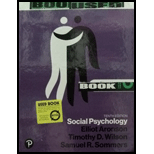
Introduction
Attachment style is demonstrated in the way a person relates to others. It is believed that a person's attachment style is formed when he or she is an infant. The relationship with the primary caregiver at this age is the primary influence on which attachment style a person develops and like maintains throughout their life. In general terms, secure attachment is exhibited by those who had a positive relationship with the primary caregiver, leading to a feeling of trust and security. Those with avoidant attachment style often had a less that satisfactory relationship with the caregiver, giving rise to distant and aloof interactions. Finally, anxious/ambivalent attachment stems from an inability to predict the caregivers' reaction to any given situation, leading to clinginess and fear of abandonment.
Want to see the full answer?
Check out a sample textbook solution
Chapter 10 Solutions
Social Psychology, 10th Edition
- DEVELOPMENT OF ONE’S PERSPECTIVE OF SELF (EPAS 2.1.1.2, 2.1.1.3; EPAS 2.1.2.1, 2.1.2.3; EPAS 2.1.3.1; EPAS 2.1.6.1; EPAS 2.1.7.2; EPAS 2.1.8.2) This paper (aka Development of Self or DOS) is designed to help students begin to identify their own values, develop critical thinking skills in analyzing social and personal forces, demonstrates knowledge of the psychological forces that impact the individual, and identify their own assumptions of how people change. You are to describe your cultural background, values and beliefs associated with your group identities, and discuss how these attributes and dimensions of who you are influence your attitudes toward and interactions with others who are “different,” as well as their attitudes toward and interactions with you.1 In doing so, this assignment is an in-depth examination of the various micro-system issues related to human behavior and their impact on your personal development. This assignment requires you to write a critical…arrow_forwardPolitical factions consist of a-Like minded individual b-Opposing groups c-Political fragmentation d-Political fusionarrow_forwardHow are individual-level white collar crimes and corporate crimes similar? Please Include in thethe discussion on whether causal factors explain these crimes is similar. Please include references.arrow_forward
- humanized short answers- What strategies could be used to help students with hearing loss to access the curriculum? What strategies can be used to help students with hearing loss be a part of the classroom community?arrow_forwardshort simple humanized answer each- How did the field of deaf education evolve, and what is the history of the debate between oral and manual communication? How are the terms deaf and hard of hearing defined? What are some characteristics of children with hearing difficulties, and why must we consider the degree, type, and age of onset of the hearing loss? What are some causes of hearing loss? How is hearing loss detected, and why is early intervention so critical? How can varying hearing levels affect a student’s cognitive, academic, social, and language development, and what can be done to maximize a student’s communication potential? What kinds of educational responses are needed for students who are deaf and hard of hearing?arrow_forwardShould U.S. foreign policy include provisions for reducing poverty in other nations of the world? Should U.S. domestic policy include provisions for reducing poverty in the United States? How are these issues similar? How are they different?arrow_forward
- Discuss Chapter 1 of Barry Glassner’s “The Culture of Fear.” Student’s may address but are not limited to discussing how the media uses individual scenarios to falsely give a wider perception of some kind, the media’ use of exaggerations and assertions and the financing of fear.arrow_forwardTake something (physical, personal or social) and change it. Tell us, what you started out with, what it looked like after you changed it, and what you did to make the change.arrow_forwardhumanized answers and couple of sentences for each: How did the field of gifted education evolve, and why is it important for giftedness to be recognized as an exceptionality? How do we define “gifts and talents,” and how are students identified? What are some characteristics of students with gifts and talents, and how can the information processing model (IPM) help us understand their needs? Why do students from culturally and linguistically different or socioeconomically disadvantaged homes and twice exceptional student continue to be under-identified for gifted-educational supports and services? What educational responses are needed to address the strengths and challenges of students with gifts and talents? What life course considerations are important for students with gifts and talents?arrow_forward
 Social Psychology (10th Edition)SociologyISBN:9780134641287Author:Elliot Aronson, Timothy D. Wilson, Robin M. Akert, Samuel R. SommersPublisher:Pearson College Div
Social Psychology (10th Edition)SociologyISBN:9780134641287Author:Elliot Aronson, Timothy D. Wilson, Robin M. Akert, Samuel R. SommersPublisher:Pearson College Div Introduction to Sociology (Eleventh Edition)SociologyISBN:9780393639407Author:Deborah Carr, Anthony Giddens, Mitchell Duneier, Richard P. AppelbaumPublisher:W. W. Norton & Company
Introduction to Sociology (Eleventh Edition)SociologyISBN:9780393639407Author:Deborah Carr, Anthony Giddens, Mitchell Duneier, Richard P. AppelbaumPublisher:W. W. Norton & Company The Basics of Social Research (MindTap Course Lis...SociologyISBN:9781305503076Author:Earl R. BabbiePublisher:Cengage Learning
The Basics of Social Research (MindTap Course Lis...SociologyISBN:9781305503076Author:Earl R. BabbiePublisher:Cengage Learning Criminalistics: An Introduction to Forensic Scien...SociologyISBN:9780134477596Author:Saferstein, RichardPublisher:PEARSON
Criminalistics: An Introduction to Forensic Scien...SociologyISBN:9780134477596Author:Saferstein, RichardPublisher:PEARSON Sociology: A Down-to-Earth Approach (13th Edition)SociologyISBN:9780134205571Author:James M. HenslinPublisher:PEARSON
Sociology: A Down-to-Earth Approach (13th Edition)SociologyISBN:9780134205571Author:James M. HenslinPublisher:PEARSON Society: The Basics (14th Edition)SociologyISBN:9780134206325Author:John J. MacionisPublisher:PEARSON
Society: The Basics (14th Edition)SociologyISBN:9780134206325Author:John J. MacionisPublisher:PEARSON





